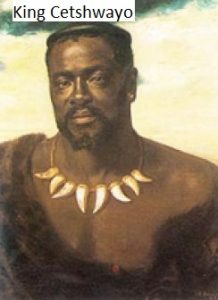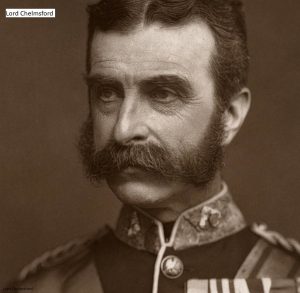This morning’s talk was presented by George Clark a retired anaesthetist and covered the Anglo Zulu conflict of 1879. The war has been described as an ill-conceived, incompetently executed and fruitless campaign. 20,000 British troops faced 40,000 Zulus, more than 10,000 Zulus were killed and 2,000 British troops died. Not the British Empire’s finest hour.
The Zulu nation was founded in about 1816 and the first king was called Shaka who instigated the buffalo horns formation when attacking the enemy which proved to be very effective particularly when combined with shorter spears and larger shields.
By 1872 Cetshwayo kaMpande had become king of the Zulus and in 1873 the kingdom was described as the most politically sophisticated, administratively integrated and militarily powerful black state in sub-Saharan Africa. The population numbered 250,000 and the army 40,000.
The British Government had negligible interest in South African territories until the discovery of diamonds there in the 1860’s and it became British policy to try to establish a confederation of South Africa to include the Boer states and to annexe the Zulu kingdom.
In 1877 Sir Bartle Frere was appointed High Commissioner for Southern Africa to achieve this aim. He decided to instigate a conflict with the Zulus by exaggerating recent border incidents and issued an ultimatum to King Cetshwayo which included the disbanding of the Zulu army. When Bartle Frere received no response to his demands a British force under the command of Lord Chelmsford invaded Zululand in January 1879 with about 17,000 troops despite the fact the British Government had not authorised any such action.
The initial invasion in three columns was largely unopposed and Chelmsford set up camp with the central column at Isandlwana but failed to establish proper defensive positions. Chelmsford decided to split his forces to support a reconnoitring party and left the camp in the charge of Colonel Pulleine. The British force was outmanoeuvred by the nearly 20,000 strong Zulu army and of the 1,700 troops in camp over 1,300 were killed with about 1,000 Zulus perishing. Messages sent to Chelmsford imploring him to send reinforcements were ignored. Of the other British forces, the right flank column advanced as far as Eshowe but was cut off and the left flank retreated on hearing of the disaster at Isandlwana.

Meanwhile a small force under Lieutenants Bromhead and Chard (about 100 soldiers) was garrisoned at Rorke’s Drift when they came under attack from a force of approximately 3,000 Zulu. This was the subject of the famous film “Zulu”. Over the next six hours the garrison was subjected to wave after wave of Zulu attacks which were repelled by gunfire and bayonets. The enemy tired and without food, eventually abandoned their attack after midnight. Over 600 Zulus were killed compared to 15 British dead and 12 wounded. 11 VC’s were awarded.
The British Government decided to complete the invasion of Zululand and sent reinforcements over the next two months to help Chelmsford achieve this. He had successes at Khambula and in the relief of Eshowe. He then mounted a second invasion with 9,000 infantry and 1,000 cavalry and cannon. At the battle of Ulundi, Cetshwayo’s army of 20,000 was decisively defeated.
Chelmsford was never given a command again and the British Government decided they no longer wanted Zululand annexing or forming part of a confederation. Instead the land was divided into thirteen chiefdoms.
This was a fascinating and detailed talk thoroughly enjoyed by all.


